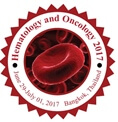Jahnvi Dhar
Maulana Azad Medical College and associated Lok Nayak Hospital, India
Title: Prevalence of Otoneurological Manifestations of Newly Diagnosed, Treatment Naïve Patients of Chronic Myeloid Leukemia – An Undiagnosed Entity
Biography
Biography: Jahnvi Dhar
Abstract
Background: Most common manifestations in CML patients are fatigue, fever, unexplained weight loss and abdominal distension. Though rare, otoneurological manifestations have been reported in 15–40 % of all leukemic patients. The prevalence of self-reported hearing loss in CML patients is around 22.4%. But audiometry assessments have shown a higher prevalence of 65.5%. Hence, presence of otoneurological findings in CML makes it a rare and exciting presentation.
Aims and Objectives: To analyze the prevalence of otoneurological complaints in patients of CML and to compare it with the age and sex matched healthy control population.
Methods: 33 newly diagnosed, treatment naïve CML cases and age and sex matched controls were recruited from October 2015 to January 2017. Otological complaints were noted at the time of presentation along with a complete otological examination. All the cases and controls were subjected to PTA (Pure tone audiometry) and BERA (Brainstem evoked response audiometry) to assess the prevalence of sensorineural hearing loss (SNHL) and the results were compared.
Results: Tinnitus was noted in 5 (15.2%), vertigo in 1 (3%) and subjective hearing loss in 10 (30.3%) cases as compared to no controls. 7 (21.2%) cases had speech frequency hearing loss (>25 dB) on Pure tone audiometry (PTA) as compared to no controls (p value 0.01). The hearing loss among the cases (n=33) was quantified as 18.30+15.05 dB and 19.39+14.68 dB in the left and right ear, as compared to the controls (n=33) having 7.34+2.64 dB and 8.22+3.27 dB, respectively, which was statistically significant for p value <0.0001.
Similarly, 22 (66.7%) cases had high frequency hearing loss on PTA and Brainstem evoked response audiometry (BERA), each as compared to only 2 (6%) controls (p value <0.0001). The hearing loss (based on PTA) for cases (n=33) was 43.94+23.41 dB (left ear) and 44.55+23.56 dB (right ear) among the cases as compared to control (n=33) having 12.27+6.26 dB (left ear) and 12.42+7.08 dB (right ear), which was significant (p value <0.0001). All the 33 cases underwent BERA at the time of diagnosis and SNHL was quantified, but it was done only in 2 controls having objective evidence of SNHL on PTA, so p value was not calculated. The amount of SNHL on BERA for the cases (n=33) was 47.88+25.59 dB and 47.88+25.59 dB in the left and right ear, respectively.
Conclusions: In our study, 22 (66.7%) CML patients had SNHL as compared to the 2 (6%) in control group which shows a higher prevalence of both, self-reported and audiologically proven SNHL in CML which is most likely due to leukocytosis and/or leukemic infiltration of the cochlea. BERA is a more sensitive technique in identifying these at risk individuals.
No study had been done till date based on newly diagnosed, treatment naïve CML patients regarding their otoneurological manifestations in comparison with a age and sex matched healthy control group. Based on the analysis of our study, it is recommended that there should be a baseline audiological profile of every CML patient at the time of diagnosis, so the timely institution of chemotherapy (Imatinib) can lead to prevention and/or treatment of SNHL.

